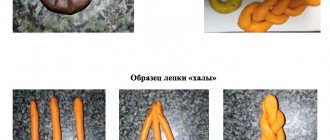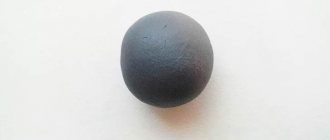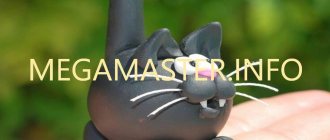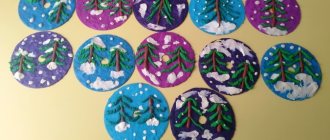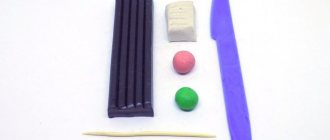Summary of a modeling lesson in the middle group “Dumbbells for Luntik”
Tokpiseva G.V. Summary of a modeling lesson in the middle group “Dumbbells for Luntik” // Sovushka. 2022. N3 (13). URL: https://kssovushka.ru/zhurnal/13/ (access date: 01/29/2022).
Order No. 98431
Goals: continue to develop children's interest in modeling; developing the ability to sculpt from life; To develop in children a desire to engage in sports and physical education; develop fine motor skills of the hands and eye; Cultivate children's interest in modeling sports equipment of their choice.
Vocabulary activation: Sports equipment, jump rope, kettlebell, dumbbells and hoop.
Materials and equipment: plasticine, modeling mass, stacks, napkins,
Preliminary work: conversations about sports and health, looking at illustrations on the topic “A healthy mind in a healthy body,” solving problem situations, practicing behavioral skills when playing sports and physical education. Tactile examination of objects (weights, jump ropes, dumbbells and hoops).
Progress of the lesson:
SMS sound.
Educator: -Guys, we received an email. Do you want to know from whom?
Educator: -Can you read it yourself? Can I read it to you? (picture with letter text)
"Hello. Luntik is writing to you. One day Kuzya and I went for a walk and we saw a berry. We wanted to eat it and look what came out of it:
(Cartoon fragment)
Help: my friends and I want to grow up big and strong, but we don’t know how to become that way. What should we do?"
Educator: Who sent us the letter?
-What do Luntik and Kuzya dream about?
-How to help Luntik and Kuza become big and strong? (play sports, do exercises, etc.)
-Why do you think Luntik and Kuzya couldn’t pick the berry?
-What needs to be done to make your hands strong?
- Look, what do you think this is? (Children express their opinions)
And with the help of what objects do we become strong and healthy? (Children answer - balls, hoops, jump ropes, dumbbells, weights).
- this is Sports equipment - this is what we use to become strong, healthy and resilient.
Now let's look at it
- Let's try to become a little stronger with the help of these items. (Children take turns coming up and trying to jump rope, spin a hoop, lift a weight and dumbbells).
- Well, let's see: have you pumped up your strength?
— Guys, how do you think we can help Luntik? (let’s give him sports equipment).
-Can I donate the sports equipment that we have? Why not?
-Then where can we get the same one, but in a small size? (blind).
-Go to the table and choose what you will use to make sports equipment from.
Independent work of children.
-Luntik lives far away. How can we give him our dumbbells, hoops, jump ropes, balls? (we will send the parcel).
Tell me: what did Luntik ask us for? Do you think we helped him?
"If you want to be healthy..."
Summary of a lesson in modeling (in the middle group)
"If you want to be healthy..."
Educational task
:
Formation of the ability to experiment and create simple images from plasticine, the ability to independently convey images of objects using available visual means (in particular plasticine);
Teach children to sculpt sports equipment in a constructive way. To form children’s initial ideas about sports equipment.
Developmental task:
Develop shaping abilities using plasticine; To develop in children the ability to properly engage in sports and physical education;
Develop fine motor skills of the hands, eye, coordination in hand movements;
Educational task:
Cultivate children's interest in modeling sports equipment of their choice.
Materials and equipment: red, yellow and black plasticine, stacks, napkins, pictures for viewing on the theme “Health” and “Sports”, pre-made figures (weight, jump rope, dumbbells and hoop).
Progress of the lesson:
Educator:
Guys, today a bear cub came to visit us, whose name is Tishka. Let's say hello to him. (Children greet the bear by the paw). He is still small and not very strong. And for him to become strong, what does he need to do? (Children answer: Do exercises, play sports, etc.)
Educator:
Tishka Bear, why are your hands so weak?
Bear: Because, guys, I don’t eat much porridge and don’t drink milk at all.
Educator:
Do you want to have weak hands too? (No) What should you and I do to be strong and eat well? (Do physical education). Look at the dumbbells lying here. They are heavy. What can we do with their help? (pump up strength). What color are they? (Yellow, red). Tishka, look at what children can do to become strong and resilient. (Physical minute to the music “Everyone around is trying to play sports”)
Bear: Children, tell me, what sports do you know? (Children answer)
Educator:
Guys, do you like physical education? (Yes). And with the help of what objects do we become strong and healthy?
(Children answer - balls, hoops, jump ropes, dumbbells, gymnastic walls). What do you think it is? (Children express their opinions)
— Sports equipment is what helps us become strong, healthy and resilient. Let's remember once again what applies to sports equipment? (Children answer).
- Now let's look at it. Let's look at the weight. What is she like? (the heaviest). (Children look at a kettlebell, a hoop, dumbbells and a jump rope).
- Let's try to become a little stronger with the help of these items. (Children take turns coming up and trying to jump rope, spin a hoop, lift a weight and dumbbells).
— Guys, what will happen if Tishka bear uses dumbbells incorrectly? (Children answer)
-Well done! Absolutely right! If you handle these items incorrectly, you can get hurt or drop a weight or dumbbells on your own or a friend's leg. Therefore, such exercises should only be performed with adults!
“Children, let’s make a jump rope, a weight, dumbbells and a hoop for Tishka.”
— Girls, what sports equipment do you like best? (jump ropes and hoop).
- Boys! And you? (weights, dumbbells).
(The teacher invites two girls to demonstrate how they jump rope and twirl a hoop, and for the boys to demonstrate how to lift a weight and dumbbells, Tishka the bear helps them)
- Well done!
- Now let's get to work. Girls will make jump ropes and hoops, and boys will make weights and dumbbells. (The teacher demonstrates how to sculpt dumbbells, a jump rope, a kettlebell, a hoop. Children choose the color of plasticine and begin to sculpt sports equipment).
- Girls, I prepared some threads for your rolling pins. You only need to make two cylinders for the handles.
(Children make the rest of the sports equipment as shown by the teacher).
- Well, children. You and I have worked hard today. What have we made? (Children's answers).
Bear: Oh, guys, I really liked it with you. I became much stronger and really wanted to eat porridge and drink milk. Well, that's it, I ran. Goodbye! See you again!
- Bye! Bye! (Children say goodbye to Tishka the bear).
Educator:
Today in class we learned what sports equipment is, how you can work with it, what it is needed for. Guys, why can’t you play with sports equipment? What will you tell your family and friends about health, about how to become strong and resilient. (Children's answers).
Modeling vegetables and fruits healthy products middle group
Summary of a modeling lesson in the middle group “Make whatever fruits or vegetables you want”
Topic: “Make whatever vegetables or fruits you want”
Goal: To develop children’s ability to choose the content of their work from a range of specific subjects.
Objectives: To foster independence and activity. Strengthen the ability to convey the shape of vegetables and fruits using a variety of sculpting techniques. Develop imagination.
Facilities:
Plasticine, modeling board, object pictures depicting vegetables and fruits, a tray with fruits and vegetables.
Methods:
Game situation, literary expression, showing how to do the work, instructions, help.
Progress of the lesson
There's a knock on the door. They pass a tray covered with a tablecloth and a letter to the door and ask if this is the group “Solnyshko”. The teacher accepts the parcel and addresses the children:
- Guys, oh, what is this? (Reads the letter) Look, Autumn sent us this. Here are the gifts of her harvest.
-Let's see what we have here. (We look at each vegetable and fruit and give a brief description, in Russian and Kalmyk).
-Guys, today we will sculpt vegetables and fruits from plasticine, and you will choose what exactly you will sculpt according to your desire.
-Let's remember how we sculpt round and oblong objects (I show in the air). We must take a whole piece of plasticine and begin to roll it in a circular motion. We are the ones who sculpt round objects. Show us how we'll ride. That's right, well done!
Topic: Make whatever toy you want as a gift for a friend.
Yulia Zhdanova
Topic: Make whatever toy you want as a gift to a friend.
Program objectives: Continue to develop figurative ideas and aesthetic perception. Cultivate attention to other children , a desire to take care of them.
Reinforce previously learned modeling techniques. Progress of the lesson. At the beginning of the lesson, ask the children about toys toys they have , which ones they like to play with. And how happy everyone is when they are given toys . You can pay attention to the toys standing in the group .
Remind children that they need to think about the shape and color of your toy . We discuss with the children who wants to make what kind of toy .
Physical education minute. We're tired, we've been sitting too long. We wanted to warm up. We put aside all our business and started charging. Then they looked at the wall. Then they looked out the window. Right, left, turn, and then turn. Let's start squatting. Don't rush to squat. And we sat down for the last time. And now they sat down.
If necessary, help children choose the right modeling techniques. During the sculpting process, clarify the techniques and the name of the sculpting form.
At the end of the lesson, consider with the children what they have sculpted and talk about the sculpted images.
Summary of educational activities “New Year's gift” Purpose: Creating conditions for the cognitive and speech development of children through a gaming situation. Objectives: Correctional - educational:.
“Cut out and paste whatever toy you want” (In the world of fairy tales and cartoons) Summary of an open lesson on appliqué on the topic: “Cut out and paste whatever toy you want” (In the world of fairy tales and cartoons) in the middle group. Didactic game “Make Tin the Snowman” Author’s didactic game for senior preschool age “Make Tin”, presented by teacher O. N. Skvortsova, MBDOU No. 21, Novopokrovsky village.
What kind of music should my child listen to? What kind of music should a child listen to? Today, parents pay less and less attention to what kind of music their child listens to when remembering.
Abstract of a collective creative activity using ICT “Gift to a friend” for children of the older group (5–6 years old) Integration of educational areas: • “Cognitive development”, • “Artistic and aesthetic development”, • “Social and communicative.
GCD summary for junior group 2. Artistic creativity (drawing). Topic: "Let's smile at each other." GCD summary for junior group 2. Artistic creativity (drawing) “We will smile at each other.” Goal: Expanding children's active vocabulary.
Summary of GCD in the preparatory group “If you want to be healthy. A visit to an otolaryngologist" Summary of educational activities in preparatory group No. 1. Topic: If you want to be healthy (visit an otolaryngologist). Goal: clarify and expand ideas.
OOD abstract for application Topic: Creating a collage “Gift for Moms” MUNICIPAL AUTONOMOUS PRE-SCHOOL EDUCATIONAL INSTITUTION BOLSHEALEKSEEVSKY COMBINED KINDERGARTEN “KALINKA” STUPINSKY.
Summary of the circle lesson “Give each other kindness” for children of senior preschool age Topic: “Wonderful old man” Summary script of the circle lesson Direction: cognitive. Age of pupils: Children of the preparatory school group 6-7 years old, in number.
GCD in the middle group “Gift for a friend” SYNOPSIS of GCD in the middle group on the topic “Gift for a friend”. Educational field “Artistic and aesthetic development” (non-traditional techniques.
Source
